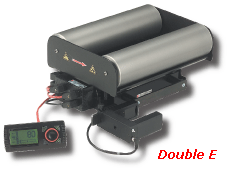New Technology Guides Web
- Published: September 30, 2005, By Deborah Donberg, Associate Managing Editor
Product Focus
Paul Henke, sales manager at Accuweb (accuweb.com), knows the importance of web guides. He also know what happens in his area ultimately is linked to advances in the presses of which they are a part.
“The speed and accuracy of new presses have brought all the peripheral components, web guides among them, ahead in technology,” Henke says. “Users are demanding more flexibility, more intelligent devices that are easier to use and set up. The industry is responding to that with less interface to the web guide. In most cases, they want the operator to have as few buttons as possible to push when they transition, for example, from a 30- to a 50-inch web. The goal is to have the operator do nothing, or as close to nothing as possible.”
This need for flexibility also applies to changing from one substrate to another, Henke says. “With converters now using a broader range of substrates, the web guides also have to be able to make the change from one substrate to another easily.”
Narrow web converters, says Henke, want the same flexibility as their wide web counterparts. “For example, if they choose an infrared sensor, they can’t run clear materials. Most want to have an ultrasonic sensor to be prepared for anything their customers might throw at them. They are spending a little extra to get flexibility, perhaps putting in PLC interfaces they may not be using right now, but they’re thinking down the road.”
At FMS USA (fms-technology.com), VP Paul Smith believes narrow and mid-web printers are seeing the most changes in web guiding. “They require more accuracy and flexibility in how their materials are read,” he says.” How are web guides changing to meet those needs? Actual physical guides themselves aren’t really changing very much, except for drives, notes Smith. “What’s really changing is control loops and sensors. The sensors themselves are becoming more accurate, and control loops are constantly being refined.”
Smith says of the future, “As press technology changes, one area in web guiding where we will see absolute, recognizable change is communication. Historically, you got a web guide with a controller, you hooked it up to electricity, and they talked to each other. Now, with advances in presses, sometimes they want to control through the PLC, for example, so you need a guide that can be talked to from a PLC.”
Four Tips for Web Guiding
The three basic types of automatic guiding control systems are electromechanical, pneumohydraulic, and electrohydraulic. Choosing the right technology for your web guiding equipment depends upon the material you run and your operating environment. Electromechanical systems are attractive for applications demanding high frequency response and accuracy and where hydraulics and pneumatics are not desirable; pneumohydraulic and electrohydraulic systems are attractive for extremely heavy loads and harsh environments.
—Ken Hopcus, web handling applications engineeering manager, Fife Corp., fife.com
Web guides should not be moving all the time. Many people see a web guide moving constantly and misinterpret the movement. They don’t realize the web guide is hovering back and forth around the desired web position instead of keeping it exactly where it needs to be. If a web guide is moving constantly, the web guide itself should be questioned.
—Bret Hardy, marketing manager, Double E Co., doubleeusa.com
Don’t buy more web guide “power” than needed. The weight of the guide frame, unwind, winder, or rewind is paramount! How can one determine the forces needed? Just unhook your present guiding device cylinder or linear actuator and pull the device with an ordinary spring scale. The important reading is just when the stand begins to move. This is called “breakaway force” and will be used to select the proper “power” of the linear actuator.
—Henry A. Rissier, president, Accuweb, accuweb.com
The entry and exit spans and the web’s angle of orientation significantly affect a guide’s ability to properly position the web. Entry/exit spans and orientation angles differ by the guide type selected. Guidelines exist for both types of guides and should be consulted to ensure optimal control.
—Tom Jonozzo, general manager, guiding systems, North American Mfg., namfg.com

For this and other web guiding new products, see our October New Products section.
Restrictions of time and space limit the number of companies, products, and trends that we can discuss in these reports. For additional information, see PFFC’s features and departments each month, consult the June Buyers Guide, and search our online archives.













